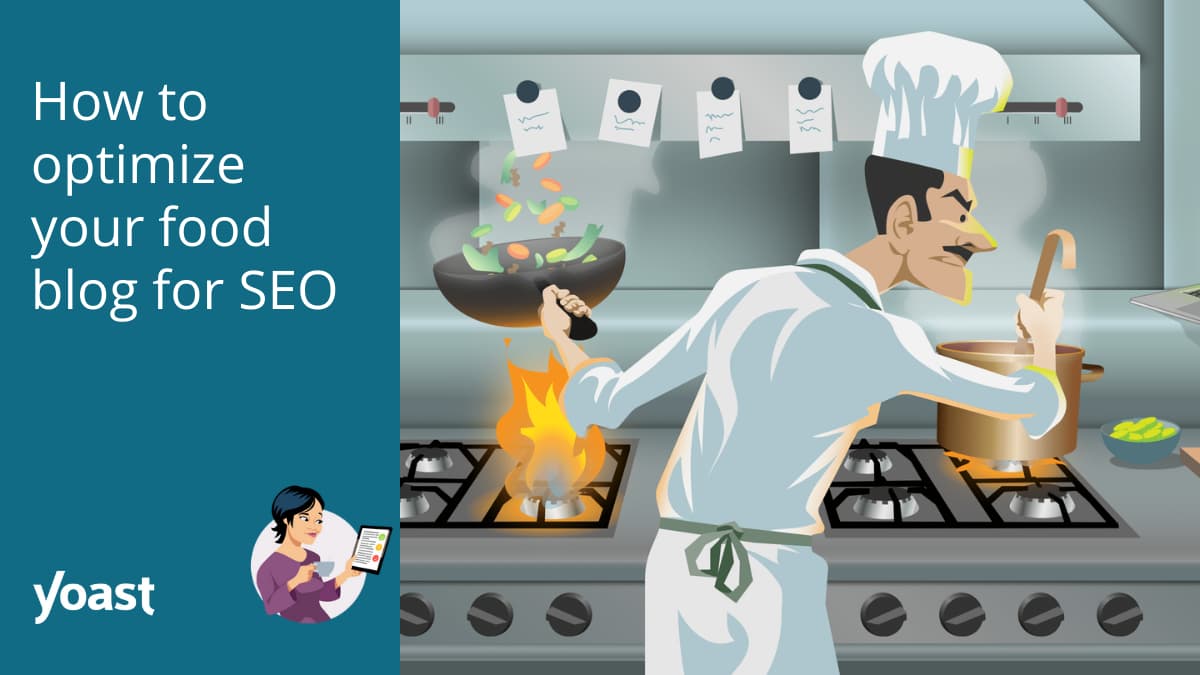 How to optimize your food blog for SEO
How to optimize your food blog for SEO
Food blogs are among the most popular type of websites you can find on the internet.Food is an essential part of our lives, so naturally, we want to talk about it.And what better way to share your passion than to blog about it! With the number of food blogs rising, it’s not easy to stand out.In this post, we’ll go over the things that will give your food blog just that little extra for both your users and in terms of SEO.
Focus on long tail keywords
This might be the most important piece of advice we can give you: focus on long tail keywords .This will have a great impact on the SEO side of your food blog.The number of food blogs grows every day.But the main problem with this large number of food blogs, is that you really need a focus to rank.
You need to find your special niche and write great content about that niche to surface on page one in Google.This is really hard.The better and more unique the niche, the easier it will be to rank.
For instance, if you search for ‘make pepperoni pizza’ on Google, you’ll get about 67 million search results.
But if you search ‘make pepperoni pizza less greasy’ instead, then Google returns about 2,9 million results.Now, that is a large number, but it’s still much smaller than 67 million.You’ll definitely have more chance to rank if you write a good article to help people make tasty pepperoni pizza with less grease! Hence, focusing on long tail will give your food blog immense SEO benefits.
Have you heard of the Yoast Google Suggest Expander ? You can use that tool to find all the things Google suggests when a user types a query in Google.With that tool, you might find the niche or long tail keyword you’d like to optimize for.For example, if you search for ‘paleo’, the tools will return keywords like ‘paleo almond butter cookies’.It’s quite an extreme example, but if you check that keyphrase for suggestions, you’ll find over 30 more topics/recipes to write about.
These can all be considered long tail keywords.
Read more: Why focus on long tail keywords? »
Make the food stand out!
Think about this: thousands of people per day visit food websites.Thousands of people have no clue about what to eat that night.About what to make as a healthy children’s snack.About what kind of cake would suit their occasion.
Food is the very bottom, most essential layer of Maslow’s pyramid .Food is emotion.That emotion needs to be reflected by your choice of theme.If you’re baking cupcakes, you should use a more playful design than if you’re posting BBQ recipes.Next to that, food is personal.
So make sure your website has a clear picture of yourself and a description of what your personal passion for food is.
What kind of food makes you happy? Make sure this is very clear from the start to bind a certain audience to your website.Add a nice tagline to your header stating just that: what kind of food is your website about.
That very passion for that specific food can be emphasized by great photography .What many people really like about food blogs is that there are photographs for every step in the baking/cooking process.
These can be quick photos taken with a smartphone, or very dedicated photos taken with a more ‘professional’ setup (good camera, lighting equipment).Whatever you do, just make sure your final shot of that amazing cupcake or delicious taco is your money shot.
Without reading your post, that image should already make the visitor hungry.And that will make him or her want to read your post.Even if your post is about nutrition and not even a recipe!
Recipes
We’re not saying that a food blog is about recipes per se, but you have to admit that most of the food blogs you’ve read contain some sort of recipes.We have talked about Schema.org before in our blog.In an essence, it’s a way to markup your content so search engines recognize very quickly what your page is about.
Google, Bing and Yandex have created a Recipe schema especially for websites like yours.
With correct implementation of recipe structured data , Google can better understand your recipe and present it to users in different ways.
Your recipes can appear in Google search results and Google Images.This is very good for your food blog, as visitors can visit your site through these rich snippets .Now, implementing structured data on your website is complicated, especially for beginners.Fortunately, the Yoast SEO plugin takes care of this difficult task for you so you don’t have to worry about it.
It’s also good to note that adding structured data doesn’t guarantee that your recipe will show up as rich snippets in Google.You can’t really influence this, so it’s entirely up to Google.Regardless, it is a good SEO practice for your food blog, so we recommend you to look into it.
The elements of a recipe
It’s always a good idea to include detailed information about your recipe such as cooking time, ingredients.
The Recipe schema contains all kinds of specific information about your recipe, of which you can find the full list here .You can always include more information about your recipe.But for the sake of SEO, it’s good to follow the recipe information mentioned in the Recipe schema.We’d like to point you to a few of these elements that stand out:
– [Nutrition Information] : really in-depth information on how healthy your recipe is.This information may be helpful for your health-driven audience.
– [Image] : as mentioned earlier, a great image really helps your post.Not just in the sense that it triggers your visitor, but it also works in [Google Images] and for instance Pinterest.
More on social later.
One more thing about nutrition.If you’re serious about adding nutrition information to your recipes or other ramblings about food, Google Knowledge Graph helps.It provides some extra information that you can use as a reference for your recipe:
That entire right side will give you more information about macronutrients, vitamins, calories.Just a tip!
Plan your seasonal posts
“Holidays are coming.” If you have specific food blog posts for seasonal occasions like Christmas, you should start planning early.If your website needs to start ranking for all your Christmas recipes in the few weeks before Christmas, you’re too late.Now we know this might be hard, especially when you’re in your first year of blogging.
But if you’ve been blogging for a couple of years, it will pay off to promote these recipes from time to time during the year.You’d be surprised how many people start planning Christmas early.
Next to that, see if you can find seasonal dishes without linking them directly to holidays as well.Categories like ‘for a winter’s evening’ or ‘a rainy day’ might also be suitable for your audience.For instance, you don’t need to wait until Christmas to eat mashed potato, roasted turkey or baked ham.You can enjoy them on a cold February day or on a weekend in May as well.Of course, those keywords will give you less traffic out-of-season.
However, you can still drive traffic and build an audience with such seasonal/holiday foods, simply because people still search and want to eat those foods! So, don’t miss out on this SEO opportunity for your food blog.
Another tip we have is to use Google Trends to do research on what people search during different times of the year.Going back to the example of Christmas foods, we can see the number of searches for those foods go up in October/November.And you can clearly see that during the summer months, those keywords will give you less traffic.People like BBQs and ice cream during these times.
Bottom line: let Google know you have these posts in time.And feel free to repost a Christmas post/recipe around Christmas, by the way.
Just make sure you check the content of the post, update it if necessary and keep the same link.If you do update a post, simply change the publish date and you’re good to go.It might give that ‘old’ post new visitors.
Your food blog and social media
How many posts about food do you see on social media every day? Probably at least one out of ten posts on your Facebook timeline is about food or beverages.About cooking or restaurants.On Instagram, people use tags such as #yummy, #foodporn, #instafood , #foodpic and multiple variations of #(om)nomnom a lot.
Searching Pinterest for ‘ salad ‘ will keep you scrolling recipes for hours.
If you have a food blog, you need to leverage social media.Find out what social media platforms your preferred audience is using and start engaging.Pinterest and Instagram seem to work really, really well.But why not leverage sites like allrecipes.com as well? We’ve written about branding before, and sites like that might help you get your name out.
Let’s not forget Youtube.Almost 2,180,000 subscribers for BarbecueWeb and a whopping 3,080,000+ subscribers for MyCupcakeaddiction ! This can only motivate you to start recording videos.Set up your channel, promote it via your website and other social media and see if it works for you.Please note that numbers like that require hard work and a lot of effort.
Give it your best shot.
We hope this article will give you some pointers for your own food blog.Feel free to share your own food blog success stories via social media or the comment section below.We’re looking forward to these!
Keep reading: How to optimize your restaurant website »
Coming up next!
– Event
April 09, 2022 Team Yoast is sponsoring WordCamp Geneve 2022, click through to see if we’ll be there, who will be there and more! [WordCamp Geneve 2022] [See where you can find us next »]
– SEO webinar
26 April 2022 Our SEO experts Joost de Valk and Jono Alderson will keep you up-to-date about everything that happens in the world of SEO and WordPress.[SEO news webinar & Goodbye Joost – April 26, 2022] [All Yoast SEO webinars »].
